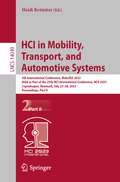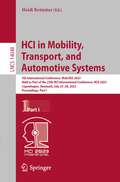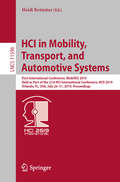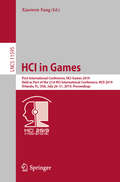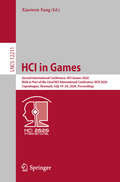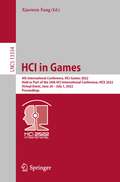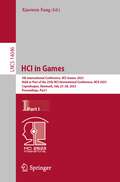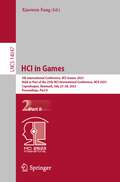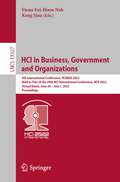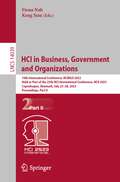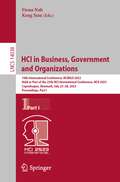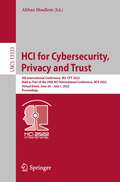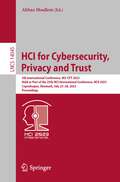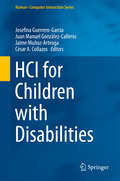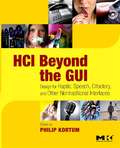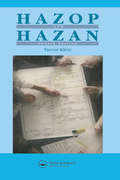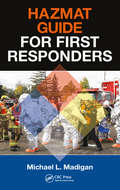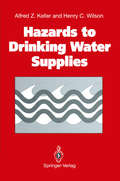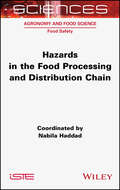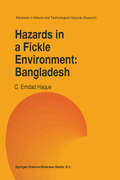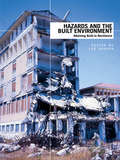- Table View
- List View
HCI in Mobility, Transport, and Automotive Systems: 5th International Conference, MobiTAS 2023, Held as Part of the 25th HCI International Conference, HCII 2023, Copenhagen, Denmark, July 23–28, 2023, Proceedings, Part II (Lecture Notes in Computer Science #14049)
by Heidi KrömkerThis book constitutes the refereed proceedings of the 5th International Conference on HCI in Mobility, Transport, and Automotive Systems, MobiTAS 2023, held as part of the 25th International Conference, HCI International 2023, held in Copenhagen, Denmark, in July 2023. The total of 1578 papers and 396 posters included in the HCII 2022 proceedings was carefully reviewed and selected from 7472 submissions. The MobiTAS 2023 proceedings were organized in the following topical sections: Part I: Autonomous and Assisted Driving; Cooperative and Intelligent Transport Systems; Urban Mobility; and Sustainable Mobility. Part II: Driver Behavior and Performance; Designing Driver and Passenger User Experience; and Accessibility and Inclusive Mobility.
HCI in Mobility, Transport, and Automotive Systems: 5th International Conference, MobiTAS 2023, Held as Part of the 25th HCI International Conference, HCII 2023, Copenhagen, Denmark, July 23–28, 2023, Proceedings, Part I (Lecture Notes in Computer Science #14048)
by Heidi KrömkerThis book constitutes the refereed proceedings of the 5th International Conference on HCI in Mobility, Transport, and Automotive Systems, MobiTAS 2023, held as part of the 25th International Conference, HCI International 2023, held in Copenhagen, Denmark, in July 2023. The total of 1578 papers and 396 posters included in the HCII 2022 proceedings was carefully reviewed and selected from 7472 submissions. The MobiTAS 2023 proceedings were organized in the following topical sections: Part I: Autonomous and Assisted Driving; Cooperative and Intelligent Transport Systems; Urban Mobility; and Sustainable Mobility. Part II: Driver Behavior and Performance; Designing Driver and Passenger User Experience; and Accessibility and Inclusive Mobility.
HCI in Mobility, Transport, and Automotive Systems: First International Conference, MobiTAS 2019, Held as Part of the 21st HCI International Conference, HCII 2019, Orlando, FL, USA, July 26-31, 2019, Proceedings (Lecture Notes in Computer Science #11596)
by Heidi KrömkerThis book constitutes the refereed proceedings of the First International Conference on HCI in Mobility, Transport, and Automotive Systems, MobiTAS 2019, held as part of the 21st International Conference on Human-Computer Interaction, HCII 2019, in Orlando, FL, USA in July, 2019. The 1274 full papers and 209 posters presented at the HCII 2019 conferences were carefully reviewed and selected from 5029 submissions. The papers cover the entire field of human-computer interaction, addressing major advances in knowledge and effective use of computers in a variety of application areas. The papers in this volume are organized in the following topical sections: interaction in autonomous and semiautonomous vehicles; driving experience; and mobility and transport.
HCI in Games: First International Conference, HCI-Games 2019, Held as Part of the 21st HCI International Conference, HCII 2019, Orlando, FL, USA, July 26–31, 2019, Proceedings (Lecture Notes in Computer Science #11595)
by Xiaowen FangThis book constitutes the refereed proceedings of the First International Conference on HCI in Games, HCI-Games 2019, held in July 2019 as part of HCI International 2019 in Orlando, FL, USA. HCII 2019 received a total of 5029 submissions, of which 1275 papers and 209 posters were accepted for publication after a careful reviewing process. The 34 papers presented in this volume are organized in topical sections named: Game Design; Gaming Experience; Serious Games; and Gamification.
HCI in Games: Second International Conference, HCI-Games 2020, Held as Part of the 22nd HCI International Conference, HCII 2020, Copenhagen, Denmark, July 19–24, 2020, Proceedings (Lecture Notes in Computer Science #12211)
by Xiaowen FangThis book constitutes the refereed proceedings of the Second International Conference on HCI in Games, HCI-Games 2020, held in July 2020 as part of HCI International 2020 in Copenhagen, Denmark.* HCII 2020 received a total of 6326 submissions, of which 1439 papers and 238 posters were accepted for publication after a careful reviewing process. The 38 papers presented in this volume are organized in topical sections named: designing games and gamified interactions; user engagement and game impact; and serious games. *The conference was held virtually due to the COVID-19 pandemic.
HCI in Games: 4th International Conference, HCI-Games 2022, Held as Part of the 24th HCI International Conference, HCII 2022, Virtual Event, June 26–July 1, 2022, Proceedings (Lecture Notes in Computer Science #13334)
by Xiaowen FangThis book constitutes the refereed proceedings of the 4th International Conference on HCI in Games, HCI in Games 2022, held as part of the 23rd International Conference, HCI International 2022, which was held virtually in June/July 2022. The total of 1271 papers and 275 posters included in the HCII 2022 proceedings was carefully reviewed and selected from 5487 submissions. The HCI in Games 2022 proceedings intends to help, promote and encourage research in this field by providing a forum for interaction and exchanges among researchers, academics, and practitioners in the fields of HCI and games. The Conference addresses HCI principles, methods and tools for better games.
HCI in Games: 5th International Conference, HCI-Games 2023, Held as Part of the 25th HCI International Conference, HCII 2023, Copenhagen, Denmark, July 23–28, 2023, Proceedings Part I (Lecture Notes in Computer Science #14046)
by Xiaowen FangThis two-volume set of HCI-Games 2023, constitutes the refereed proceedings of the 5th International Conference on HCI in Games, held as Part of the 24th International Conference, HCI International 2023, which took place in July 2023 in Copenhagen, Denmark.The total of 1578 papers and 396 posters included in the HCII 2023 proceedings volumes was carefully reviewed and selected from 7472 submissions. The HCI in Games 2023 proceedings intends to help, promote and encourage research in this field by providing a forum for interaction and exchanges among researchers, academics, and practitioners in the fields of HCI and games. The Conference addresses HCI principles, methods and tools for better games.
HCI in Games: 5th International Conference, HCI-Games 2023, Held as Part of the 25th HCI International Conference, HCII 2023, Copenhagen, Denmark, July 23–28, 2023, Proceedings, Part II (Lecture Notes in Computer Science #14047)
by Xiaowen FangThis two-volume set of HCI-Games 2023, constitutes the refereed proceedings of the 5th International Conference on HCI in Games, held as Part of the 24th International Conference, HCI International 2023, which took place in July 2023 in Copenhagen, Denmark.The total of 1578 papers and 396 posters included in the HCII 2023 proceedings volumes was carefully reviewed and selected from 7472 submissions. The HCI in Games 2023 proceedings intends to help, promote and encourage research in this field by providing a forum for interaction and exchanges among researchers, academics, and practitioners in the fields of HCI and games. The Conference addresses HCI principles, methods and tools for better games.
HCI in Business, Government and Organizations: 9th International Conference, HCIBGO 2022, Held as Part of the 24th HCI International Conference, HCII 2022, Virtual Event, June 26 – July 1, 2022, Proceedings (Lecture Notes in Computer Science #13327)
by Fiona Fui-Hoon Nah Keng SiauThis book constitutes the refereed proceedings of the 9th International Conference on HCI in Business, Government and Organizations, HCIBGO 2022, held as part of the 23rd International Conference, HCI International 2022, which was held virtually in June/July 2022. The total of 1271 papers and 275 posters included in the HCII 2022 proceedings was carefully reviewed and selected from 5487 submissions. The HCIBGO 2022 proceedings focuses in topics such as artificial intelligence and machine learning, blockchain, service design, live streaming in electronic commerce, visualization, and workplace design.
HCI in Business, Government and Organizations: 10th International Conference, HCIBGO 2023, Held as Part of the 25th HCI International Conference, HCII 2023, Copenhagen, Denmark, July 23–28, 2023, Proceedings, Part II (Lecture Notes in Computer Science #14039)
by Fiona Nah Keng SiauThis two-volume set of HCIBGO 2023, constitutes the refereed proceedings of the 10h International Conference on HCI in Business, Government and Organizations, held as Part of the 24th International Conference, HCI International 2023, which took place in July 2023 in Copenhagen, Denmark.The total of 1578 papers and 396 posters included in the HCII 2023 proceedings volumes was carefully reviewed and selected from 7472 submissions. The HCIBGO 2023 proceedings focuses in topics such as artificial intelligence and machine learning, blockchain, service design, live streaming in electronic commerce, visualization, and workplace design.
HCI in Business, Government and Organizations: 10th International Conference, HCIBGO 2023, Held as Part of the 25th HCI International Conference, HCII 2023, Copenhagen, Denmark, July 23–28, 2023, Proceedings, Part I (Lecture Notes in Computer Science #14038)
by Fiona Nah Keng SiauThis two-volume set of HCIBGO 2023, constitutes the refereed proceedings of the 10h International Conference on HCI in Business, Government and Organizations, held as Part of the 24th International Conference, HCI International 2023, which took place in July 2023 in Copenhagen, Denmark.The total of 1578 papers and 396 posters included in the HCII 2023 proceedings volumes was carefully reviewed and selected from 7472 submissions. The HCIBGO 2023 proceedings focuses in topics such as artificial intelligence and machine learning, blockchain, service design, live streaming in electronic commerce, visualization, and workplace design.
HCI for Cybersecurity, Privacy and Trust: 4th International Conference, HCI-CPT 2022, Held as Part of the 24th HCI International Conference, HCII 2022, Virtual Event, June 26 – July 1, 2022, Proceedings (Lecture Notes in Computer Science #13333)
by Abbas MoallemThis book constitutes the refereed proceedings of the 4th International Conference on HCI for Cybersecurity, Privacy and Trust, HCI-CPT 2022, held as part of the 23rd International Conference, HCI International 2022, which was held virtually in June/July 2022. The total of 1271 papers and 275 posters included in the HCII 2022 proceedings was carefully reviewed and selected from 5487 submissions. The HCI-CPT 2022 proceedings focuses on to user privacy and data protection, trustworthiness and User Experience in cybersecurity, multi-faceted authentication methods and tools, HCI in cyber defense and protection, studies on usable security in Intelligent Environments, as well as the impact of the Covid-19 pandemic on cybersecurity
HCI for Cybersecurity, Privacy and Trust: 5th International Conference, HCI-CPT 2023, Held as Part of the 25th HCI International Conference, HCII 2023, Copenhagen, Denmark, July 23–28, 2023, Proceedings (Lecture Notes in Computer Science #14045)
by Abbas MoallemThis proceedings, HCI-CPT 2023, constitutes the refereed proceedings of the 5th International Conference on Cybersecurity, Privacy and Trust, held as Part of the 24th International Conference, HCI International 2023, which took place in July 2023 in Copenhagen, Denmark. The total of 1578 papers and 396 posters included in the HCII 2023 proceedings volumes was carefully reviewed and selected from 7472 submissions. The HCI-CPT 2023 proceedings focuses on to user privacy and data protection, trustworthiness and user experience in cybersecurity, multifaceted authentication methods and tools, HCI in cyber defense and protection, studies on usable security in Intelligent Environments. The conference focused on HCI principles, methods and tools in order to address the numerous and complex threats which put at risk computer-mediated human-activities in today’s society, which is progressively becoming more intertwined with and dependent on interactive technologies.
HCI for Children with Disabilities (Human–Computer Interaction Series)
by Josefina Guerrero-Garcia Juan Manuel González-Calleros Jaime Muñoz-Arteaga César A. CollazosIn this book the authors present an HCI principle-based approach to develop applications to assist children with disabilities. Design knowledge related to developing complex solution for this audience is explained from an interaction design point of view. Different methodologies, models and cases studies are covered with the aim of helping practitioners to adopt any of the proposed techniques presented in this book. HCI methodologies that adopt an agile strategy are presented, including novel techniques at different development steps, such as: board games, agile planning, agile implementation, method engineering. As this is a huge research field the authors do not just focus on a specific disability but test their methods in different contexts with excellent results. Readers of this book will find both a well-organized and structured set of methodologies and also material that has been tested and refined throughout years of research. Using detailed case studies the reader is guided towards specific solutions which will also provide insights into how to address related problems.
HCI Beyond the GUI: Design for Haptic, Speech, Olfactory, and Other Nontraditional Interfaces (Interactive Technologies)
by Philip KortumAs technology expands and evolves, one-dimensional, graphical user interface (GUI) design becomes increasingly limiting and simplistic. Designers must meet the challenge of developing new and creative interfaces that adapt to meet human needs and technological trends. HCI Beyond the GUI provides designers with this know how by exploring new ways to reach users that involve all of the human senses. Dr. Kortum gathers contributions from leading human factors designers to present a single reference for professionals, researchers, and students.Explores the human factors involved in the design and implementation of the nontraditional interfaces, detailing design strategies, testing methodologies, and implementation techniquesProvides an invaluable resource for practitioners who design interfaces for children, gamers and users with accessibility needsOffers extensive case studies, examples and design guidelines
Hazop & Hazan: Identifying and Assessing Process Industry Hazards, Fouth Edition
by Trevor A. KletzThis revised edition provides the basics of applying hazard and operability study (Hazop) and hazard analysis (Hazan). Hazop is a creative but systematic method of identifying hazards in process plants. Hazard analysis is then used to quantify the risks from these hazards, and to assess how far to go in reducing them. This book is presented in easy-to-read style and explains: what a Hazop is, who carries it out, when, and how long it should take; points to watch during a Hazop; an example of a Hazop; Hazops on flowsheets; the stages of Hazard analysis; the Fatal Accident Rate; risks to the public; estimating how often an accident will occur, with examples; and pitfalls in Hazan.
Hazop & Hazan: Identifying and Assessing Process Industry Hazards, Fouth Edition
by Trevor A. KletzThis revised edition provides the basics of applying hazard and operability study (Hazop) and hazard analysis (Hazan). Hazop is a creative but systematic method of identifying hazards in process plants. Hazard analysis is then used to quantify the risks from these hazards, and to assess how far to go in reducing them. This book is presented in easy-to-read style and explains: what a Hazop is, who carries it out, when, and how long it should take; points to watch during a Hazop; an example of a Hazop; Hazops on flowsheets; the stages of Hazard analysis; the Fatal Accident Rate; risks to the public; estimating how often an accident will occur, with examples; and pitfalls in Hazan.
HAZMAT Guide for First Responders
by Michael L. MadiganThe goal of this book is to help train hazmat response teams and other responders in disaster training, techniques, and planning.The book will also help define and sharpen training plans and assumptions. Focusing on lessons learned from real-world experiences during actual disasters, the book will help to establish a well-trained professional 1st responder, individuals, and teams. Such lessons are emphasized so that planners and responders learn to anticipate how their community is likely to react under real disaster conditions, and plan accordingly.
HAZMAT Guide for First Responders
by Michael L. MadiganThe goal of this book is to help train hazmat response teams and other responders in disaster training, techniques, and planning.The book will also help define and sharpen training plans and assumptions. Focusing on lessons learned from real-world experiences during actual disasters, the book will help to establish a well-trained professional 1st responder, individuals, and teams. Such lessons are emphasized so that planners and responders learn to anticipate how their community is likely to react under real disaster conditions, and plan accordingly.
Hazards in the Food Processing and Distribution Chain
by Nabila HaddadFoodstuffs can be the vector of a variety of hazards that adversely affect the health of the consumer. Viruses are the leading causes of foodborne infectious diseases, and pathogenic bacteria and bacterial toxins are the leading agents of zoonotic diseases in Europe, not to mention other biological hazards, such as parasites, which can spread to humans through food. In addition to these biological dangers, chemicals used in agriculture, environmental pollutants and additives can all end up on the consumer&’s plate and ultimately damage their health. Hazards in the Food Processing and Distribution Chain covers both chemical and microbiological dangers, aiming to outline the principle of risk analysis with some examples to illustrate the reasoning involved in this process.
Hazards in the Food Processing and Distribution Chain
by Nabila HaddadFoodstuffs can be the vector of a variety of hazards that adversely affect the health of the consumer. Viruses are the leading causes of foodborne infectious diseases, and pathogenic bacteria and bacterial toxins are the leading agents of zoonotic diseases in Europe, not to mention other biological hazards, such as parasites, which can spread to humans through food. In addition to these biological dangers, chemicals used in agriculture, environmental pollutants and additives can all end up on the consumer&’s plate and ultimately damage their health. Hazards in the Food Processing and Distribution Chain covers both chemical and microbiological dangers, aiming to outline the principle of risk analysis with some examples to illustrate the reasoning involved in this process.
Hazards in a Fickle Environment: Bangladesh (Advances in Natural and Technological Hazards Research #10)
by C.E. HaqueThis book evolved from a collaborative research project between the University of Manitoba, Canada and Jahangirnagar University, Bangladesh, which commenced in 1984 to study the problems of river channel migration, rural population displacement and land relocation in Bangladesh. The study was sponsored by the International Development Research Center (IDRC), based in Ottawa, Canada. It was through this project that I started my journey into disaster research more than thirteen years ago with basically an applied problem of massive magnitude in Bangladesh. I spent two- and-a half-years, in two stages, in Bangladesh's riparian villages to collect the empirical data for this study. Then the growing disaster discourse throughout the 1980s, especially its conceptual and theoretical areas, drew me in further, gluing my interest to these issues. In the 1990s, during my research and teaching at Brandon University, Canada, I realized that, despite the large body of literature on natural disasters, there was no work that synthesized the approaches to nature-triggered disasters in a comprehensive form, with sufficient empirical substantiation. In addition, despite the great deal of attention given to disasters in Bangladesh, I found no detailed reference book on the topic. Natural hazards and disasters, in my view, should be studied under a holistic framework encompassing the natural environment, society and individuals. Overreaction to the limitations of technocratic-scientific approaches-the control and prevention of physical events through specialized knowledge and skills-has resulted in a call for "taking the naturalness out of natural disasters.
Hazards and the Built Environment: Attaining Built-in Resilience
by Lee BosherAs a specialist in disaster preparation, you have huge responsibilities: a failure to prepare for natural and human-induced disasters costs lives and money. When a natural or human-induced disaster hits a built-up area the amount of damage it does will depend largely on the extent to which the built assets in the area were developed to withstand it. To fail in this respect is therefore both ethically and financially negligent. What kinds of structural and non-structural alterations can be made to protect buildings from large-scale disasters? How can we reduce the threat of these disasters, as well as the damage they cause? Presenting seven guiding principles, drawn from a broad range of disciplines and approaches, this book tackles the difficult questions about what can be done to attain built-in resilience. With contributions from many renowned experts and upcoming researchers in the fields concerned, it comprehensively assesses the wide range of issues faced by practitioners. Whether you're studying construction management, researching hazard resilience issues or working on construction projects in hazardous regions, this book is for you.
Hazards and the Built Environment: Attaining Built-in Resilience
by Lee BosherAs a specialist in disaster preparation, you have huge responsibilities: a failure to prepare for natural and human-induced disasters costs lives and money. When a natural or human-induced disaster hits a built-up area the amount of damage it does will depend largely on the extent to which the built assets in the area were developed to withstand it. To fail in this respect is therefore both ethically and financially negligent. What kinds of structural and non-structural alterations can be made to protect buildings from large-scale disasters? How can we reduce the threat of these disasters, as well as the damage they cause? Presenting seven guiding principles, drawn from a broad range of disciplines and approaches, this book tackles the difficult questions about what can be done to attain built-in resilience. With contributions from many renowned experts and upcoming researchers in the fields concerned, it comprehensively assesses the wide range of issues faced by practitioners. Whether you're studying construction management, researching hazard resilience issues or working on construction projects in hazardous regions, this book is for you.
